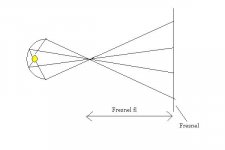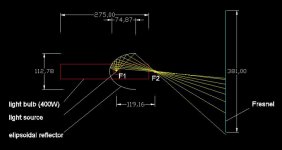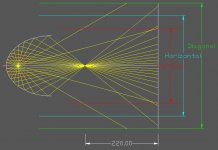I received my ellipsoidal reflector from the group buy today. Where is the best position to place it? Do my image relect where it is supposed to be mounted? That image is for an real ellipsoidal reflector, not for the cone-axis ellipsoidal and thus that image is not really correct.
Will the theory for the placement still be almost the same?
Will the theory for the placement still be almost the same?
Attachments
Ace got his too, and he has run a quick test on it. you might be able to get some input from him.
as far as the result, Ace found it has less hotspot than the standard ellipsoidal reflector. and it seems brighter because it spreads the hotspot away from the center.
as far as the result, Ace found it has less hotspot than the standard ellipsoidal reflector. and it seems brighter because it spreads the hotspot away from the center.
Me2! said:You need a custom fresnel to use this.
What do you mean? What should be custom about it, and why?
A normal fresnel is designed for light focused at a pint perpendicular to its center.
This unit would give great even light to a spotlight. You will get a double layered circle of light.
It focuses light to a ring so you would need a fresnel designed to create parallel light from a hoop.
The design of the fresnel would be like:
cut a 3mm wide strip from your fresnel corner to corner. Drill a hole in one end. Put a pin through it and spin it through 360deg. the fresnel rings would then be shaped like what you need for this reflector.
if the reflector focus diameter is 6" for example you would need to do this witha 3" dia fresnel to get the ring pattern.
Hope that explains it. I was in the group buy for the original chinese reflector but i backed out when they changed the design.
This unit would give great even light to a spotlight. You will get a double layered circle of light.
It focuses light to a ring so you would need a fresnel designed to create parallel light from a hoop.
The design of the fresnel would be like:
cut a 3mm wide strip from your fresnel corner to corner. Drill a hole in one end. Put a pin through it and spin it through 360deg. the fresnel rings would then be shaped like what you need for this reflector.
if the reflector focus diameter is 6" for example you would need to do this witha 3" dia fresnel to get the ring pattern.
Hope that explains it. I was in the group buy for the original chinese reflector but i backed out when they changed the design.
correction
I meant 6" diameter fresnel. The center of the fresnel needs to arc around matching the focal diameter.
if the reflector focus diameter is 6" for example you would need to do this witha 3" dia fresnel to get the ring pattern.
I meant 6" diameter fresnel. The center of the fresnel needs to arc around matching the focal diameter.
in theory, IF you have a point light source, you will have light forcused to a ring. in practice, one will never get a point light source. I havn't set up it with a fresnel yet ( i am still search for a fresnel with ideal FL on the field fresnel side). I model it with a software. Basicly, with a CDM-T lamp, it gives a 5-8 cm evenly lit light spot at it focal plane. and it reproduced the same pattern when I lit up my lamp.
now the light cone is too narrow for a 220mm FL fresnel. what you can do is to put a condensor lens just before the focal plane on the lamp side to make the beam wider. Again I didn't set it up with a fresnel lens, but I put in a magnify glass and got a wider beam.
so what you really need to do is to do some experiments. set up the lamp, reflector, condensor lens, and fresnel. each one should be able to move relative to others. then adjust the distance between them, so the light covers the size of the lcd screen, and light patch after first fresnel ( suppose you are using split design ) should be the similar size as the fresnel itself even at some distance.
in a word, you have to experiment a lot before you put everything in a enclosure. the theory will give you gudiance, but in DIY world, we don't know the precise charecristics of each component we are using, experiments is the only way to perfect our results.
now the light cone is too narrow for a 220mm FL fresnel. what you can do is to put a condensor lens just before the focal plane on the lamp side to make the beam wider. Again I didn't set it up with a fresnel lens, but I put in a magnify glass and got a wider beam.
so what you really need to do is to do some experiments. set up the lamp, reflector, condensor lens, and fresnel. each one should be able to move relative to others. then adjust the distance between them, so the light covers the size of the lcd screen, and light patch after first fresnel ( suppose you are using split design ) should be the similar size as the fresnel itself even at some distance.
in a word, you have to experiment a lot before you put everything in a enclosure. the theory will give you gudiance, but in DIY world, we don't know the precise charecristics of each component we are using, experiments is the only way to perfect our results.
Me2! said:A normal fresnel is designed for light focused at a pint perpendicular to its center.
This unit would give great even light to a spotlight. You will get a double layered circle of light.
It focuses light to a ring so you would need a fresnel designed to create parallel light from a hoop.
18,
I agree with the spirit of your post. Yes, this is likely used in a 8-10mm arc and some of the light will be off at an angle that is useful to the fresnel. This is rough DIY as you say.
However, when you are at the point of going to an elliptical cold reflector you expect some finesse in exchange for your money. You are probably at the high end so there is no point in useing well engineered optics in a way that is very different from their theoretical purpose.
If you just want rough, the obvious solution is buy a cheap cold mirror and put a regular fresnel in front. Visible light is sent back though the arc and out the front. A cheap fresnel will yield Newton's rings as the reflected light mixes with the straight path light but it will get you a cheap cold reflector .
Someone buying cold ellipsoid reflectors has different expectations so I think my "custom fresnel" post is reasonable for that audience.
I agree with the spirit of your post. Yes, this is likely used in a 8-10mm arc and some of the light will be off at an angle that is useful to the fresnel. This is rough DIY as you say.
However, when you are at the point of going to an elliptical cold reflector you expect some finesse in exchange for your money. You are probably at the high end so there is no point in useing well engineered optics in a way that is very different from their theoretical purpose.
If you just want rough, the obvious solution is buy a cheap cold mirror and put a regular fresnel in front. Visible light is sent back though the arc and out the front. A cheap fresnel will yield Newton's rings as the reflected light mixes with the straight path light but it will get you a cheap cold reflector .
Someone buying cold ellipsoid reflectors has different expectations so I think my "custom fresnel" post is reasonable for that audience.
eliptical reflector
I think that I can make an eliptical reflector out of inox.
Here is a picture of my "designed" reflector.
I have a few concernes before I go into the trouble of building it
1. to make the reflector smaller, most of the light will pass througn the glass of my bulb. Do you think that it might blow up?
2. if I actually build this do you think that I will not need a condenser?
3. I can actually design it bigger so the light will pass outside the glass enclosure, but that would mean bigger reflector.
4. what do you think of inox as a reflecting material
I think that I can make an eliptical reflector out of inox.
Here is a picture of my "designed" reflector.
I have a few concernes before I go into the trouble of building it
1. to make the reflector smaller, most of the light will pass througn the glass of my bulb. Do you think that it might blow up?
2. if I actually build this do you think that I will not need a condenser?
3. I can actually design it bigger so the light will pass outside the glass enclosure, but that would mean bigger reflector.
4. what do you think of inox as a reflecting material
Attachments
do you have any idea how to do it? i can draw 1000 elipsoidal shapes but don´t have the equipment to built 1.
First you have to buld a mold
I have don it before
you build it out of plywood stacked and then you shape it with a "torno" (I dont know the english word for it - it is a machine that spins around an axis a piece of anything and then with tools you can form it to have a symmetrical round shape, any shape you want)
the mold can only be very close, but never perfect, but i think it can be good enough - considering that the light source to begin with is not an exact point source.
after building a mold i can take it with a piece of inox steel to a place that form it (I have done it before with aluminium sheet but they will form any 2d metal)
I have don it before
you build it out of plywood stacked and then you shape it with a "torno" (I dont know the english word for it - it is a machine that spins around an axis a piece of anything and then with tools you can form it to have a symmetrical round shape, any shape you want)
the mold can only be very close, but never perfect, but i think it can be good enough - considering that the light source to begin with is not an exact point source.
after building a mold i can take it with a piece of inox steel to a place that form it (I have done it before with aluminium sheet but they will form any 2d metal)
Correct me if i am wrong, but according to my sketch the elipsoidal will get more light to the focal point than any other reflector, but the light distribution on the fresnel will still be uneven. We would get a lot of light concentration in the center, but much less on the edges.
I think a parabolic is the best way to go....
I think a parabolic is the best way to go....
Attachments
Ellipse vs parabolic reflector
Mihari,
Youve hit a great topic. Like you say the only shortcomming of the ellipse is the uneveness of the light. Therefore pick an ellipse which is not too wide an angle. the 220mm fresnel for example needs about 50 degrees of light.
The parabolic has the same problem but for a different reason! First you would need a parabola the size of your lcd. Then you have to worry about the light that comes straight forward not hitting the parabola. It will spread out in a cone the same as the ellipse. It will be brightest in the middle. In addition you have waves coming from 2 angles. Diverging from the middle and parallel. You could put a small spherical reflector in front of your bulb so everything is sent to the parabola, but this makes a dark spot in the middle because the parabola cannot get light past this small mirror and its support structure.
What to do? Either method results in a working system but 1 is not better. It comes down to the messiness of the implementation and how you overcome the issues.
Mihari,
Youve hit a great topic. Like you say the only shortcomming of the ellipse is the uneveness of the light. Therefore pick an ellipse which is not too wide an angle. the 220mm fresnel for example needs about 50 degrees of light.
The parabolic has the same problem but for a different reason! First you would need a parabola the size of your lcd. Then you have to worry about the light that comes straight forward not hitting the parabola. It will spread out in a cone the same as the ellipse. It will be brightest in the middle. In addition you have waves coming from 2 angles. Diverging from the middle and parallel. You could put a small spherical reflector in front of your bulb so everything is sent to the parabola, but this makes a dark spot in the middle because the parabola cannot get light past this small mirror and its support structure.
What to do? Either method results in a working system but 1 is not better. It comes down to the messiness of the implementation and how you overcome the issues.
I think that getting an evenly distributed light on the fresnel can only be accomplished with an aspheric condenser.
I found this one you think it could work?
http://www.surplusshed.com/pages/item/l2030.html
I found this one you think it could work?
http://www.surplusshed.com/pages/item/l2030.html
I have that lens but im not going to try using it for that.
It is a small diameter so it has to be close to the lamp. It is fairly thick so it will heat unevenly and may crack. Maybe someone else has used it sucessfully but id go with a large diameter thinner lens.
It is a small diameter so it has to be close to the lamp. It is fairly thick so it will heat unevenly and may crack. Maybe someone else has used it sucessfully but id go with a large diameter thinner lens.
Me2! said:220mm fresnel needs 70degrees
330mm fresnel needs 50degrees
read wrong angle on the blueprint.
Well, that actually depends on what size of lcd you have.
For a 7", a 220mm fl fresnel needs 44 degrees and a 330mm fl fresnel needs 30 degrees.
For a 15" it is 82 degrees for the 220 mm fl. and 60 degrees for the 330mm fl.
- Status
- Not open for further replies.
- Home
- General Interest
- Everything Else
- The Moving Image
- Optics
- Position of cone-axis ellipsiodal?


